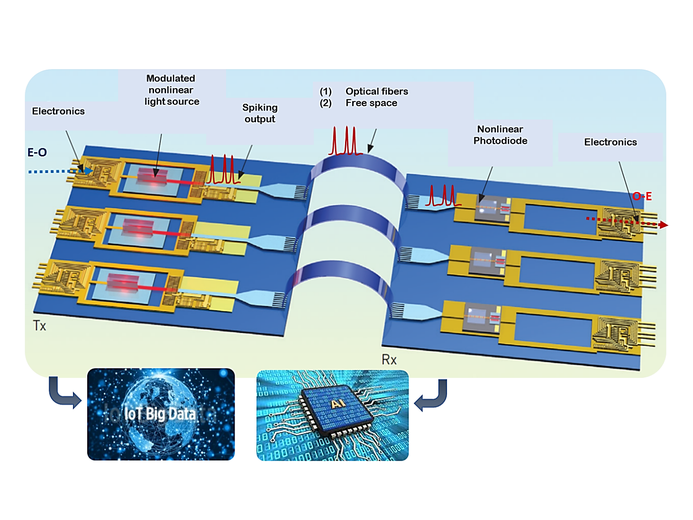Tech Project
Description of the challenges faced by the Tech Project
ChipAI explores a portfolio of future light-based nanotechnologies using cheap, ultra-small, efficient and fast light sources and detectors capable of being utilized in future brain-inspired systems and networks. These will offer great potential to improve the quality of life of European and international citizens through considerable scientific, economic and societal benefits. The main applications include artificial intelligence and machine learning, and high-bandwidth telecoms and so will contribute to a wide range of industrial sectors with global interest, e.g. information and communications technologies, healthcare, active and healthy ageing, agriculture, public administrations and transport. Notably, the research addressed by ChipAI project is driven by interdisciplinary collaborations between electrical and optical engineers, experimental and theoretical physicists and computer and machine learning scientists, and others. Being part of the interdisciplinary team of ChipAI’s project, the artist will have access to a creative and scientific environment and thinking. Importantly, the artist will have access to all the project’s technologies and data produced. This includes material samples and proof-of-concept prototypes, scientific reports, data sets, and sounds, videos and images produced by a complete set of state-of-the-art equipment.
Brief description of technology
The same way the internet revolutionized our society, the rise of Artificial Intelligence (AI) that can learn without the need of explicit instructions is transforming our life. AI systems are currently being used in key emerging industries as for example autonomous driving, Internet of Things, and healthcare diagnostics. AI uses brain inspired neural network algorithms powered by computers. However, these central processing units (CPU) are extremely energy inefficient at implementing these tasks. This represents a major bottleneck for energy efficient, scalable and portable AI systems. Reducing the energy consumption of the massively dense interconnects in existing CPUs needed to emulate complex brain functions is a major challenge. ChipAI aims at solving these challenges by developing an energy-efficient brain-inspired nanophotonic architecture technology using neuron-like nanoscale light sources and detectors to realize interconnected spike-encoded synapses for optical neural networks, and hence capable of addressing the predicted future needs of AI systems and computing processors.
What the project is looking to gain from the collaboration and what kind of artist would be suitable
The main goal of this proposal is to establish a long-standing connection between emerging light and artificial intelligence technologies developed in ChipAI and the general public by means of art. The proposed activities aim at discovering new ways to perceive light-based and AI-related disruptive technologies by the general audience by pursuing the following key objectives: 1. Design and creation of multifunctional products, while using ChipAI’s laboratory material samples and proof-of-concept prototypes as sources of inspiration; 2. Considering the societal challenges of creating sustainable and energy-efficient artificial intelligence technologies, activities engaging public with this emerging field of science and technology, or even the creation of a significant public dissemination of project’s activities may be explored by the artist;
Resources available to the artist
INL is comprised by state-of-the-art research facilities, exclusively dedicated to nanoscience, nanocharacterization, system & IC design solutions, biological sciences, nanofabrication & processes and nanomaterial synthesis. The artist will gain access to the INL facilities and will be provided with office open space, internet connection and free accommodation at the INL guest house for up to 30 days. He/she will have the possibility to interact with the international multidisciplinary research community at the institute. The artist will also have access to open databases, computer codes, image and digital data sets, as well as tools, material samples and proof-of-concept prototypes.


